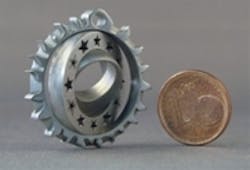New company provides micro laser sintering technology
Chemnitz, Germany - 3D-Micromac AG, a provider of highly efficient laser micromachining systems, and EOS GmbH, Krailling, Germany, a provider of solutions in additive manufacturing, are bringing their respective know-how in micro laser sintering technology into a new corporation, 3D MicroPrint GmbH (Chemnitz). This new company will advance the development and commercialization of new micro laser sintering (MLS) technology and will identify and establish more solutions in the field of microtechnology.
The companies have been developing MLS technology together since 2006. The first system successfully began operation at a German research institute earlier this year.
"Demand for very small parts, which are difficult to manufacture using conventional processes, is rising tremendously. Micro laser sintering provides solutions for three major trends: individualization, functional integration, and miniaturization," said Dr. Hans J. Langer, founder and CEO of EOS GmbH.
"Working with layer thicknesses of ≤ 5 micron, focus diameters of ≤ 30 micron, and powder particle size of ≤ 5 micron, the MLS technology opens up new dimensions," said Joachim Gobner, one of the business managers of 3D MicroPrint. "With MLS, it is even possible to produce moveable component assemblies."
Gobner, formerly project head of MLS at EOS and head of the Chemnitz technical center, and Tino Petsch, CEO of 3D-Micromac, were appointed as business managers of 3D MicroPrint. The company's headquarters is located in Chemnitz.
3D MicroPrint is located on the Chemnitz Smart Systems Campus. The new location brings a major expansion of production space. Development and service capacities are also being expanded.
Micro laser sintering is an additive manufacturing technology. Based on digital 3D design data, parts are built from metal powders, layer by layer, using a laser beam. The process is also known as industrial 3D printing. This process enables the production of parts with complex 3D structures when conventional manufacturing processes reach their limits. Even a lot size one of a part can be produced at reasonable costs-per-part. The technology offers a high degree of freedom of design, and the capacity to integrate and optimize functionality.
Individualization of products even in series production processes can be accomplished without difficulty. Target applications include nozzles for the automotive industry, components for medical devices, or the individualization of jewelery. Aside from that, a growing demand for microparts can be observed in the areas of mold-making and aerospace technology.
